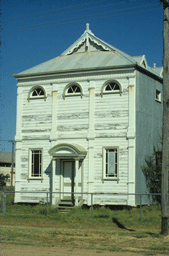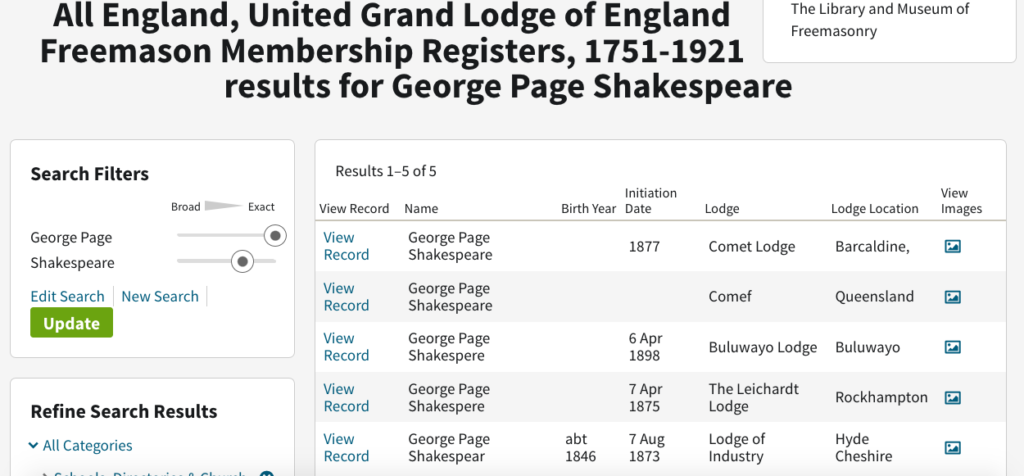Using Masonic records to help track men across Queensland and beyond
William Page Shakespeare was a well-known publican moving west as Queensland’s central western railway line was constructed. His memory is retained through the iconic Shakespeare Hotel in Barcaldine. Masonic records available online have helped to trace his journey from England to Queensland and Africa. As George Page Shakespear, we find him installed in the Lodge of Industry (361) of Cheshire on 7 August 1873, a railway servant aged of 27 residing at Ryde, Cheshire, England.[1]

Comet Lodge, Barcaldine
Next, we find him installed in the Leichhardt Lodge (932) in Rockhampton on 7 April 1875. Two years later he was one of four members of the Leichhardt Lodge to petition for the formation of the Comet Lodge (1060) in Dingo Creek, which was granted its warrant in March 1877. Other petitioners included railway surveyors Robert Ballard and Willoughby Hannam.
This Lodge moved west with its members. The information about these moves is available through Lane’s Masonic Records at http://www.hrionline.ac.uk/lane. Update, this link can now be found at https://www.dhi.ac.uk/lane/index.php. From this website we can trace the Lodge’s moves from the Drafting Department of the Railway Department in Dingo Creek to the Masonic Hall in 1877. Within its first year, these men had been able to have their own building erected. This was the building that moved along the line – to Cometville (later Comet) in 1878, Emerald in 1879, Bogantungan in 1881, Pine Hill in 1883, Jericho in 1885, Barcaldine in 1886. Here the men met in Bro. H G Eccles offices while they waited for the building to be moved and reconstructed.
In 1900-01, the original building was replaced by this two-storey building, said to have been based on the original. This photo was taken just before conservation work was carried out in the early 1980s.[2]
Using the online sources
The Freemasonry records on Ancestry.com are found in the ‘Category of Professional & Organisational Directories’ within ‘Schools, Directories & Church Histories’. Limiting your name search to these categories will soon reveal all the United Grand Lodge of England Freemason Membership Registers from many English-speaking countries.

Extract in Ancestry for George Page Shakespeare.
The Ancestry index entry for George Page Shakespeare dates his initiation in the Comet Lodge as in being 1877 in Barcaldine. This generalisation misleads us as researchers until we investigate the linked image and the details contained in Lane’s Masonic Records. However, the index does lead us to another record for George. While his wife Emma remained in Barcaldine managing the Shakespeare Hotel, George travelled to Africa, where he was admitted to the Buluwayo Lodge in April 1898, stating that he was from his original lodge in England – No 361. While George Page Shakespeare returned to Barcaldine intermittently over following years, Africa continued to attract him until his death in Capetown in 1911. [3]
A very useful tool for searching Lane’s Masonic Records is the ‘Keyword’ field. Using it, I discovered that Lodges from every Australian State are included; that 636 lodges are listed under the Keyword ‘India’ and that there were up to 13 lodges in Bury St Edmunds; to one of which some of my extended ancestral family could have belonged. It shows clearly that wherever English, Irish and Welsh men settled across the world, there may well have been a Lodge formed. Scottish lodges are not included as they were not part of the English Constitution; disappointing for me as I endeavour to learn about the involvement in Scotland of my Scottish great great grandfather, John Kennedy Donald. Lane’s Masonic Records also includes a list of terms used through the records – very useful in adding to my understanding of a Lodge’s operation.

Lane’s Masonic Records banner
While a name search is not available in Lane’s Masonic Records, used in conjunction with the index on Ancestry, you may learn where an ancestor lived, when he travelled there, where the men met and who his acquaintances were. These Masonic records can be used to trace men from many occupations – the Comet Lodge members included a coach driver, photographer, carpenter, telephonist, saddler, railway guard, accountant, teacher, surveyor, merchant, as well as many other occupations typical of developing communities. In 1897-98, the Buluwayo Lodge included an accountant, a builder, an architect, a storekeeper, a miner and a stationer, among others. One of my extended family members, John Skuthorp was a drover when a mason in Tambo, Queensland.
The movement of men is just one of the aspects that can be discovered about our ancestors’ lives through Masonic Lodge records: well worth delving into if there are Lodge members in your families.
[1] Shakespear, George Page, Lodge of Industry, England, United Grand Lodge of England Freemason Membership Registers, 1751-1921, digital image, accessed through Ancestry.com; Lane’s Masonic Records, HRI Online Publications, Oct 2011, http://www.hrionline.ac.uk/lane .
[2] Comet Lodge Building, Barcaldine 1980. Michael Keniger, University of Queensland Library.
[3] Western Champion, 23 December 1911, p. 3.

I think that using Masonic records are an under-utilised bonus to our genealogy family history. As it happens I finally got to attend a presentation by Rob Hamilton on the recent Unlock the Past cruise and was fascinated to hear of the way they can be accessed and what they’re likely to divulge. It was really timely to read your blog and have the links and knowledge set out explain how they’ve assisted you.